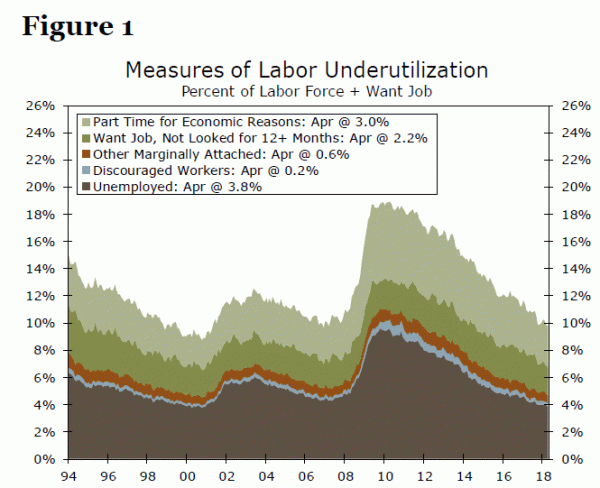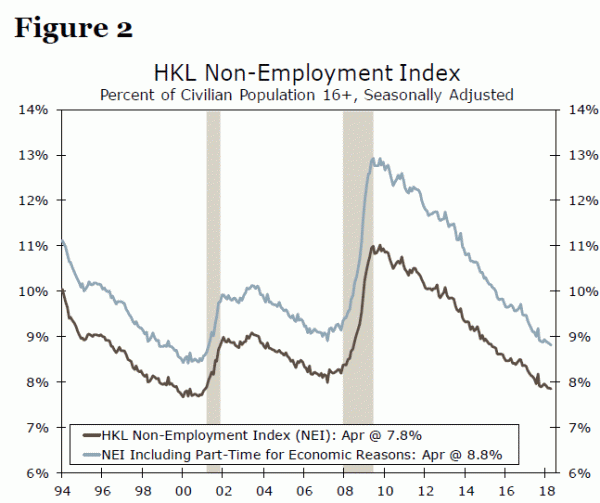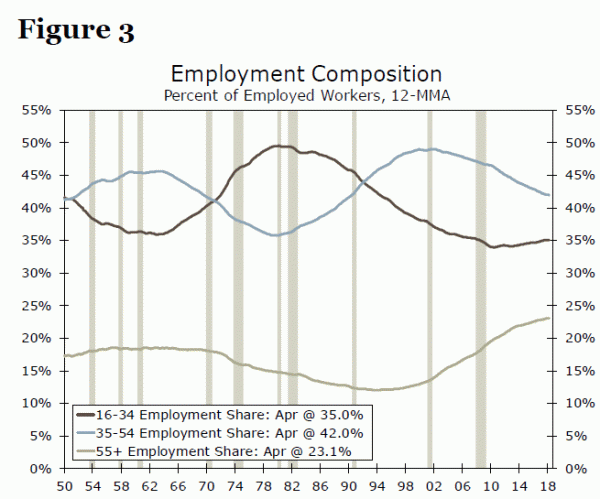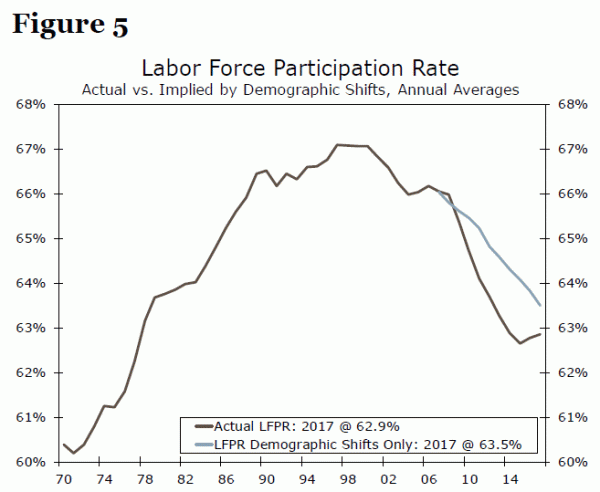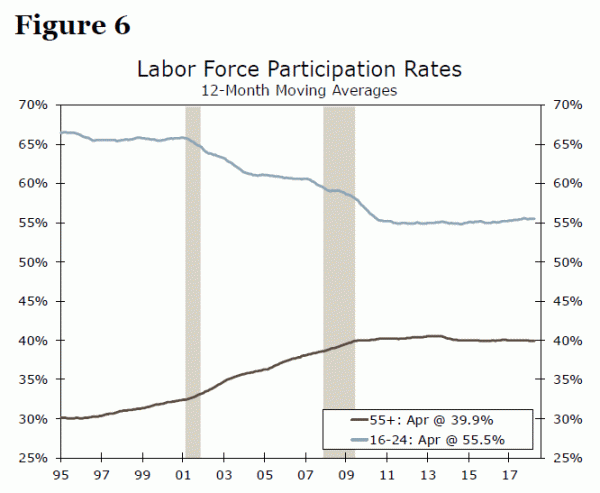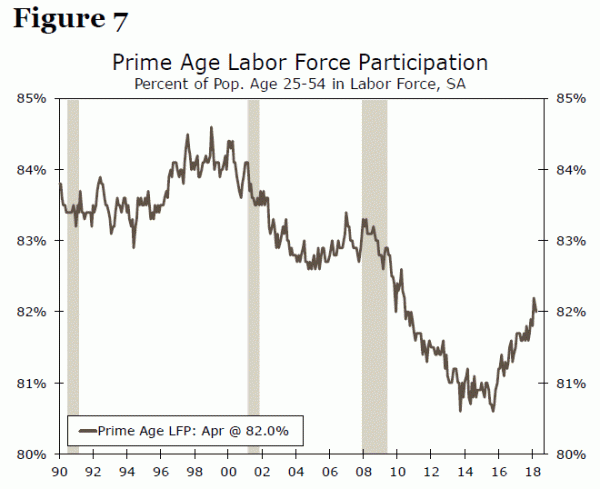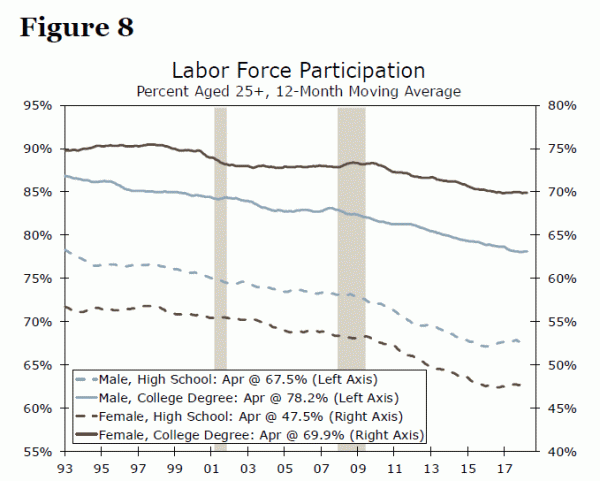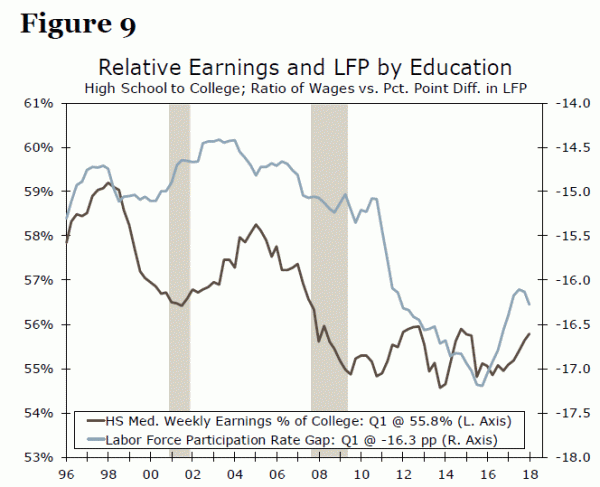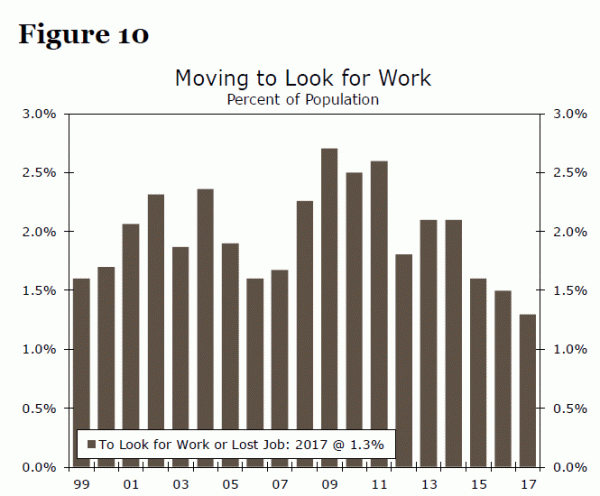Executive Summary
A growing chorus of employers is expressing difficulty in finding workers as the labor market has tightened over the past few years. Currently, there is only one unemployed person per job opening compared to 6.5 in the wake of the Great Recession. The unemployment rate is lower today than at any point in the past 18 years. Even more generous measures that account for the workers not officially counted as unemployed point to the tightest labor market since the height of the 1991-2001 expansion.
There are a number of reasons to believe that the unemployment rate, currently 3.9 percent, will soon sink below the 3.8 percent rate last reached in April 2000. An older workforce and slower population growth among working-age adults alone point to lower measures of unemployment. Just how low the unemployment rate may go, however, will depend on whether demographic constraints are combatted by greater labor force participation.
We see a number of tailwinds to labor force participation, including rising wages and the increased ability/need for older workers to remain employed. Yet mismatches between the location of job growth and the skills of workers not currently employed remain hurdles to a full recovery in participation among prime-age workers, as does opioid abuse and high incarceration rates. These challenges suggest that even accounting for lower labor force participation today, the job market is tight, as indicated by the official unemployment rate.
Beyond the Unemployment Rate, the Labor Market Is Tight
In no other period has the traditional unemployment rate been met with as much skepticism as it has in the current economic expansion. To be considered unemployed in the “official” measure of unemployment, workers must have actively searched for a job in the prior four weeks. Yet the severity of the past recession led many workers to at least temporarily stop looking for employment, limiting the efficacy of the unemployment rate in capturing labor market slack earlier in this cycle.
Nearly nine years on, the unemployment rate sits at an 18-year low of 3.9 percent. It is not the only measure, however, that suggests the labor market has more than recovered from the Great Recession. Whether including workers specifically not looking for a job because they are discouraged about their prospects, or taking a wider view and counting any worker who claims to want a job, the pool of available labor is also at an 18-year low (Figure 1). The only sign we see that the slack may not be quite as low as during the heyday of the late-1990s/early-2000s is when adding under-employed workers to the mix. That pushes the rate of available workers up to 9.8 percent, two ticks above the 9.6 percent low of the previous expansion.
It is worth noting, however, that not all workers outside the labor force or officially unemployed are equally likely to become employed. Researchers at the Federal Reserve, therefore, have created a measure of “non-employment” that reflects the varying likelihood that any person without a job will become employed.1 When also including under-employed workers, this highly encompassing measure of slack also indicates the labor market is the tightest it has been since the 1991-2001 expansion (Figure 2)..
How Low Can You Go?
With the slack disappearing even on the fringes of the labor market, how much lower might the unemployment rate go? That depends in part, of course, on the near term demand outlook for labor. Continued growth in the economy through 2019—likely at the strongest pace of the expansion to boot—should keep workers in high demand. However, the lows to which the unemployment rate could plumb will also depend on supply constraints, which tend to be more structural.
Among those is an aging workforce. Nearly a quarter of workers are over the age of 55 (Figure 3). Older workers have lower rates of unemployment since they are less likely to switch jobs and more likely to exit the labor force if unemployed. Therefore, the older composition of the workforce, on its own, favors the unemployment rate breaching the 3.8 percent low of 2000.
The aging workforce is also a function of slower population growth in recent decades. Since 2010, the civilian population ages 16-64 has grown at an average annual rate of 0.4 percent per year compared to 1.1 percent as recently as the 2000s (Figure 4). Slower growth in the supply of potential labor has constrained the availability of workers beyond the cyclical demand drivers. In a previous report, we estimated that in light of this dynamic, monthly payroll gains would only need to average 70,000-100,000 to keep the unemployment rate unchanged.2 Taking the top end of that range, our expectations for employment growth to average around 160,000 through the end of 2019 suggests the unemployment rate could reach as low as 3.5 percent if the labor force participation rate remains unchanged at 62.9 percent.
Labor Force Participation: Willing and Able?
Any assumption about where the labor force participation rate will go has considerable uncertainty associated with it. Demographics have weighed heavily on the participation rate as more of the Baby Boomer generation has aged into retirement. Holding participation rates constant since 2007 suggests shifting demographics have accounted for about 80 percent of the drop in labor force participation over the past decade (Figure 5).
That said, participation rates among older workers have trended up since the early 2000s as health and longevity have improved and the responsibility to save for retirement has shifted to more employees. At the same time, young Americans (under age 25) have delayed entering the workforce in favor of more schooling. Participation among both the young and old, however, has been fairly stable the past few years as the stronger economy (and financial markets) has at least temporarily arrested these longer-term trends (Figure 6).
Prime Age Participation: Limited Room for Improvement
A bigger question surrounding the potential amount of slack remaining in the labor market hangs over Americans in the prime of their working years. Labor force participation for the population ages 25-54 has yet to fully recover following the Great Recession (Figure 7). Those still sitting on the sidelines represent an important potential source of labor market slack, should they become willing and able to search for work. If the prime-age participation rate immediately returned to its 2007 level, the flood of new workers would bring the overall unemployment rate up to 4.5 percent— much higher than the current 3.9 percent.
We see some scope for the prime participation rate to continue rising, although a full recovery to pre-recession levels faces a number of hurdles. On the bright side, the strong job market (meaning higher wages and increased job opportunities) is encouraging more Americans to enter the labor force. Since the start of 2016, the prime-age participation rate has ticked up 0.8 percentage points, a difference of 1.0 million individuals through April. This has put the prime participation rate back to where it was in late 2010.
Breaking out trends by education and gender, we see that the recent recovery in participation rates has been concentrated among men and women with less schooling. Men with only a high school education, who experienced the largest drop in participation post-recession, have returned to the labor force more quickly than most other groups since January 2016 (Figure 8). This uptick in participation has coincided with rising relative wages for high school-educated workers (Figure 9), which indicates increased demand for these workers and larger income returns to work. As demand for labor and wages continue to rise, in particular for Americans who have been most likely to drop out of the labor force, we would expect to see further gains in overall labor force participation.
Yet structural factors will likely prevent labor force participation from returning to its level in the mid-2000s. Among those is a mismatch between where workers are willing and able to live and where job openings are located. Since 2008, 80 percent of new jobs have been created in the nation’s largest metros (the 54 areas with populations of one million or more). Only 56 percent of the U.S. population lives in these metros, however, and Americans have become more reluctant to relocate over the past 30 years.3 The percentage of the population moving to look for work or because of a lost job fell to 1.3 percent in 2016-2017, the lowest level since the series began in 1998 (Figure 10).
New jobs also may not match the skillsets of workers on the sidelines. Trade and automation have reduced the demand for workers in less-skilled but high-paying fields like manufacturing, which employs about two-thirds as many people as it did 30 years ago. Lower-skilled jobs have primarily been added in the service sector, which tends to pay much lower wages than manufacturing. While high-school educated men in the 1980s made about 75 percent of what their college-educated counterparts earned, this ratio has fallen to about half.4 Relative wages for high-school educated workers have increased somewhat in the past two years, at the same time as the participation gap has shrunk, but are not likely to return to historical levels. Americans who do not have the skills to work in emerging fields and are unwilling to accept the reduced wages for what low skilled jobs are available remain unlikely to re-enter the workforce even as the labor market continues to tighten.
Putting aside the nature or location of jobs being created, several other long-term factors are weighing particularly hard on the labor force participation rate of prime-age workers. Recent research has attributed about 20 percent of the decline in men’s labor force participation from 1999 to 2015 to increased opioid prescriptions during this period.5 Opioid abuse has not been caused by the labor market’s weakness following the Great Recession, but rather by the availability of prescriptions.6 While efforts are being made to reduce opioid prescriptions and address addictions, the issue looks unlikely be solved by a hot labor market and will likely continue to weigh on participation rates over the near term.
Furthermore, rising incarceration rates over the past 40 years mean a larger portion of the population have criminal records. A recent study estimates that 3 percent of the U.S. adult population has been to prison and that 8 percent of adults have a felony conviction.7 A conviction makes it harder for individuals to work because of employer reluctance to hire applicants with criminal records. The U.S. incarceration rate has declined slowly since peaking in 2006, but it will take a long time to meaningfully reduce the percentage of the population with criminal records.
Conclusion: Even with Low Participation, the Job Market Is Tight
The labor market is as tight as it has been at any time since the 1990s, as measured by the unemployment rate and broader measures of labor market slack. Under-employment is slightly more elevated than at the end of the previous economic expansion, but not by much. Rising wages and greater availability of jobs may convince more Americans to enter the labor force. However, structural factors will keep labor force participation lower than in previous decades. Therefore, we see little remaining slack inside or outside the official definition of the labor force. Employers are likely to continue struggling to fill open positions, and we expect continued upward pressure on wages as a result.




